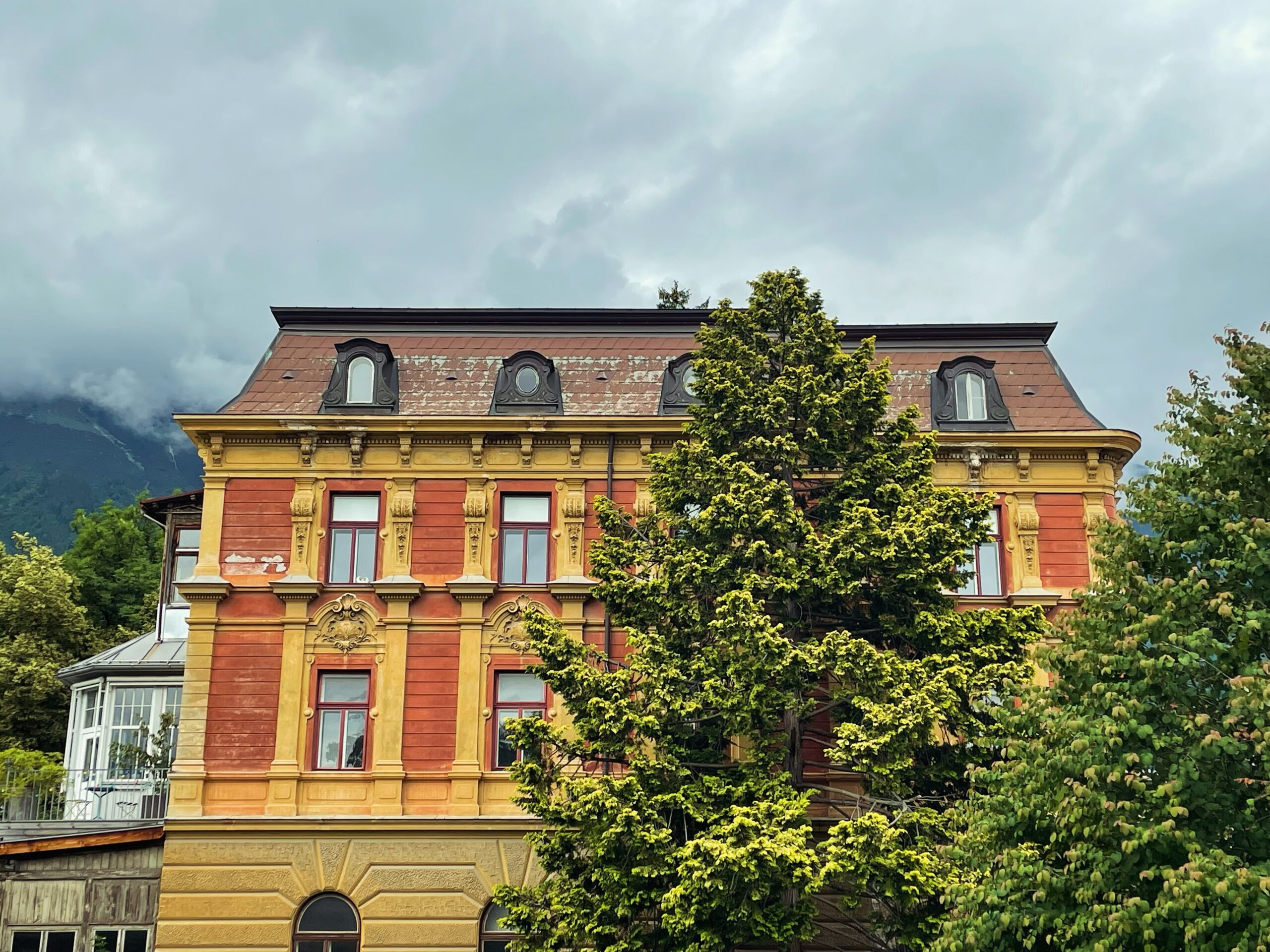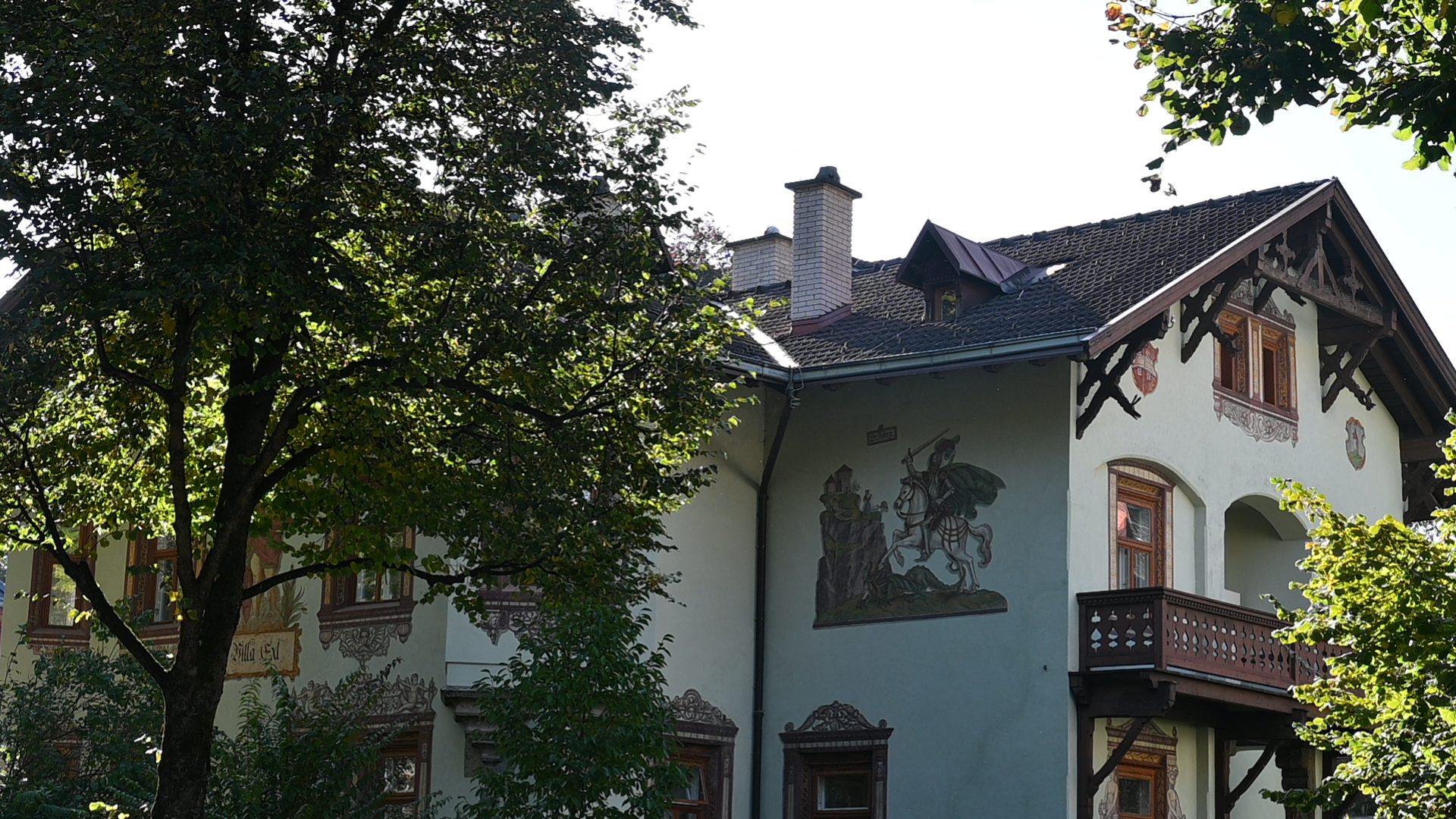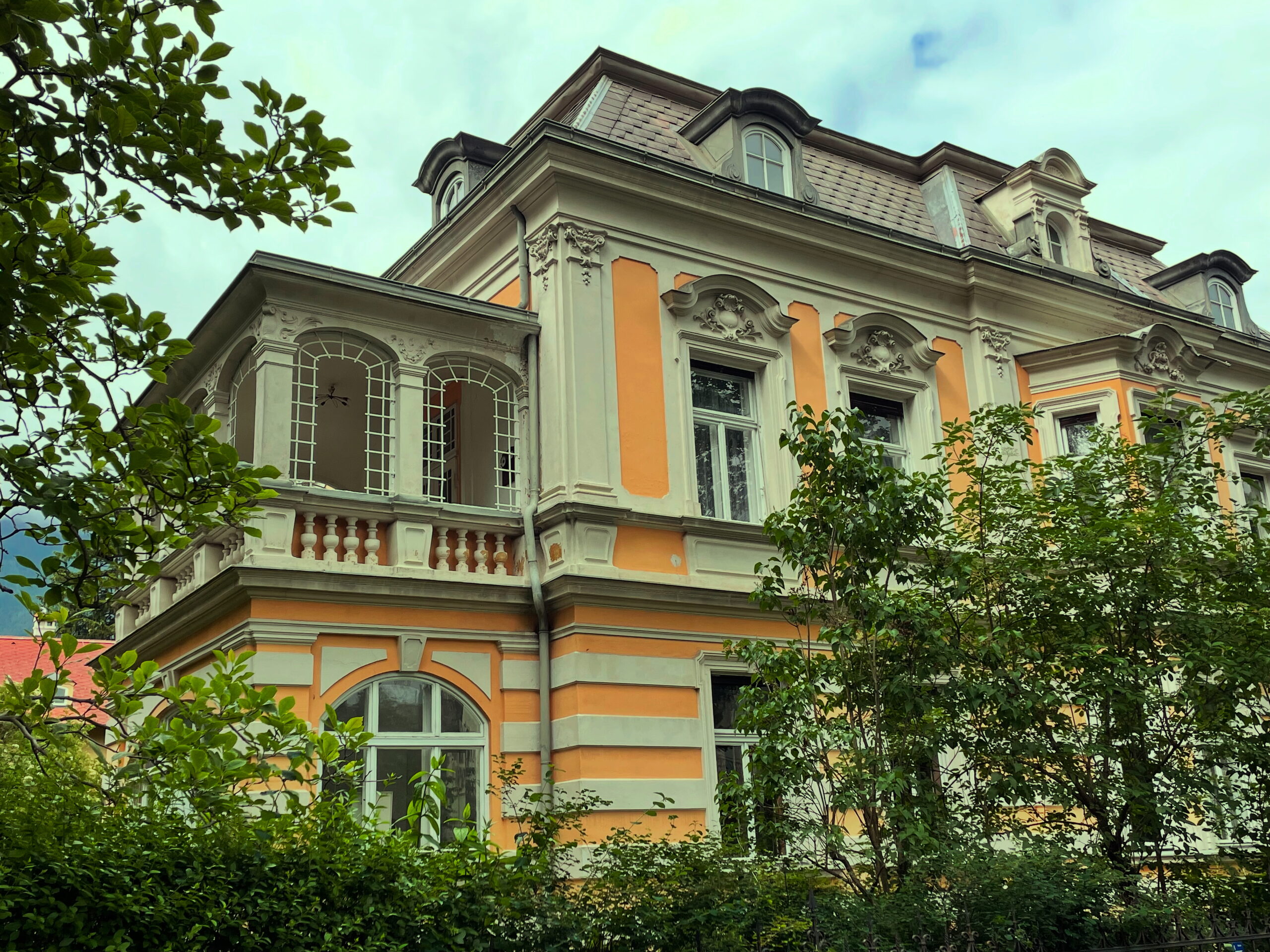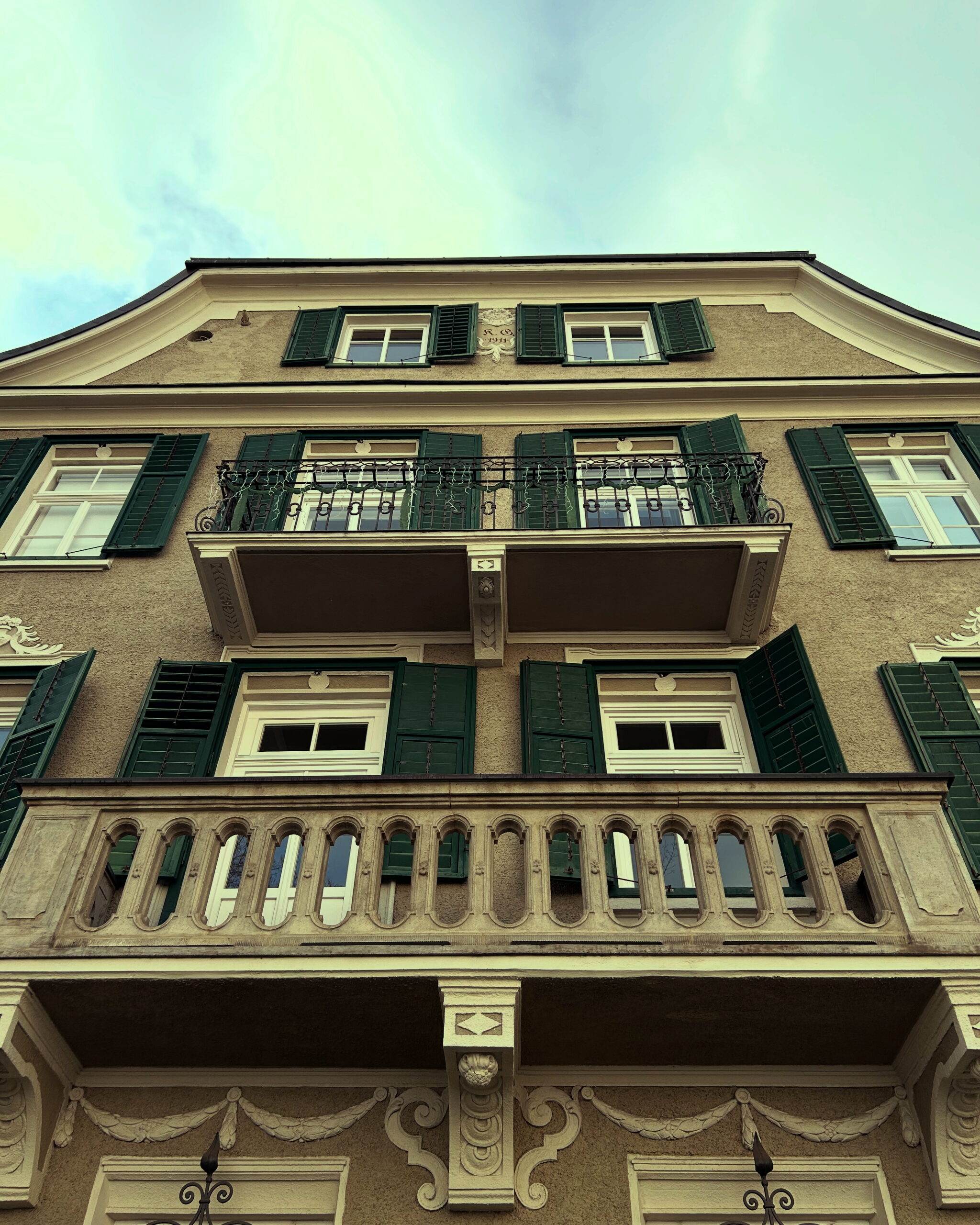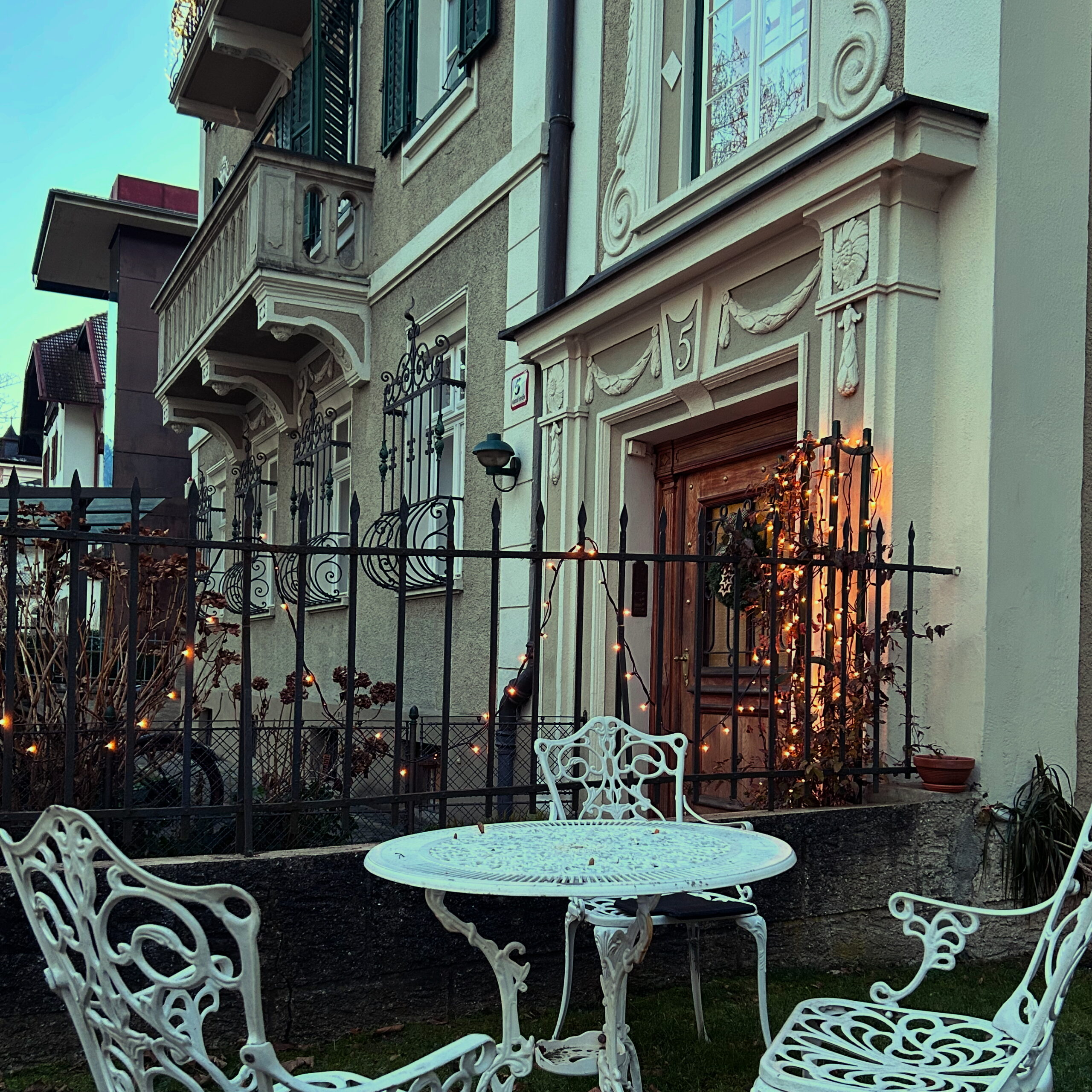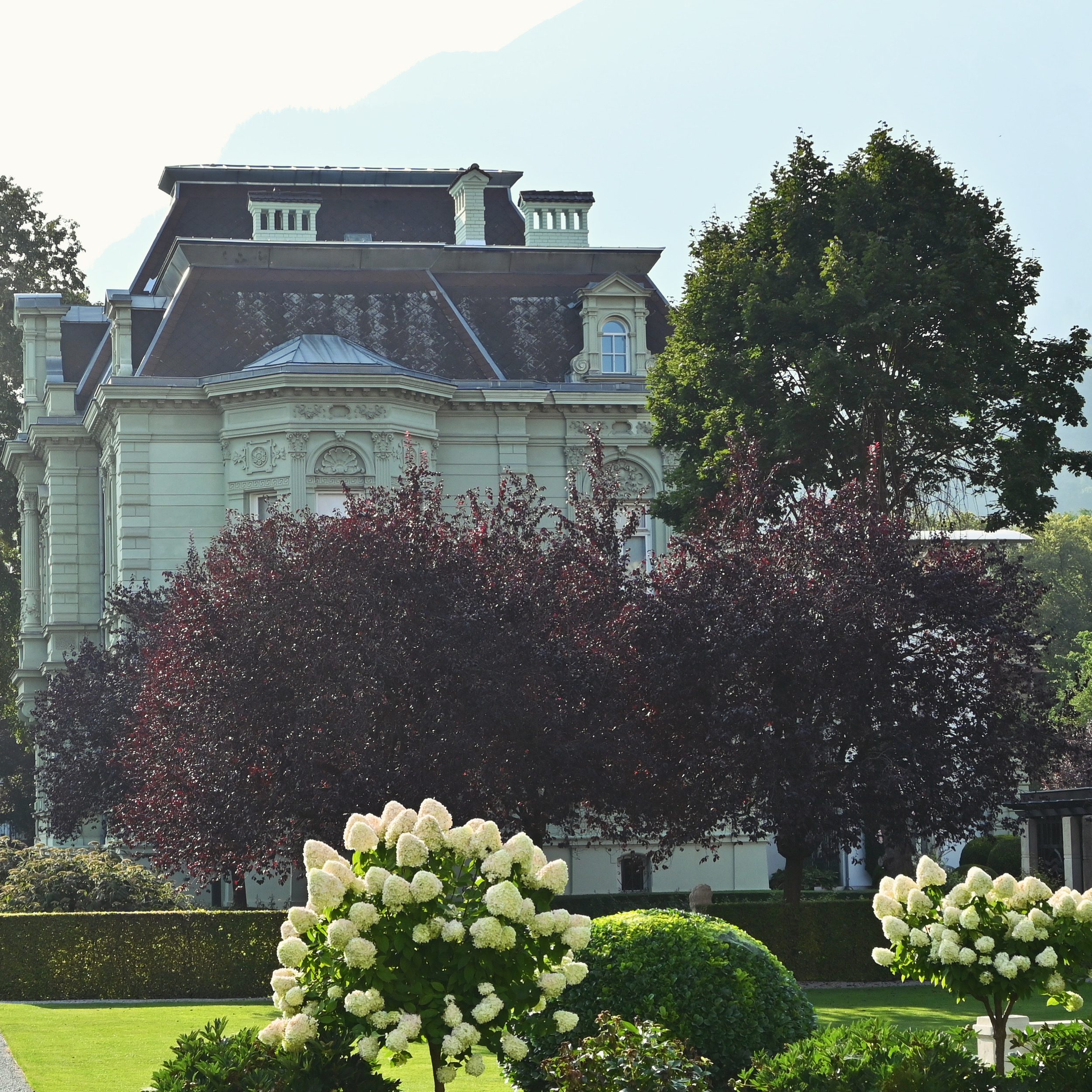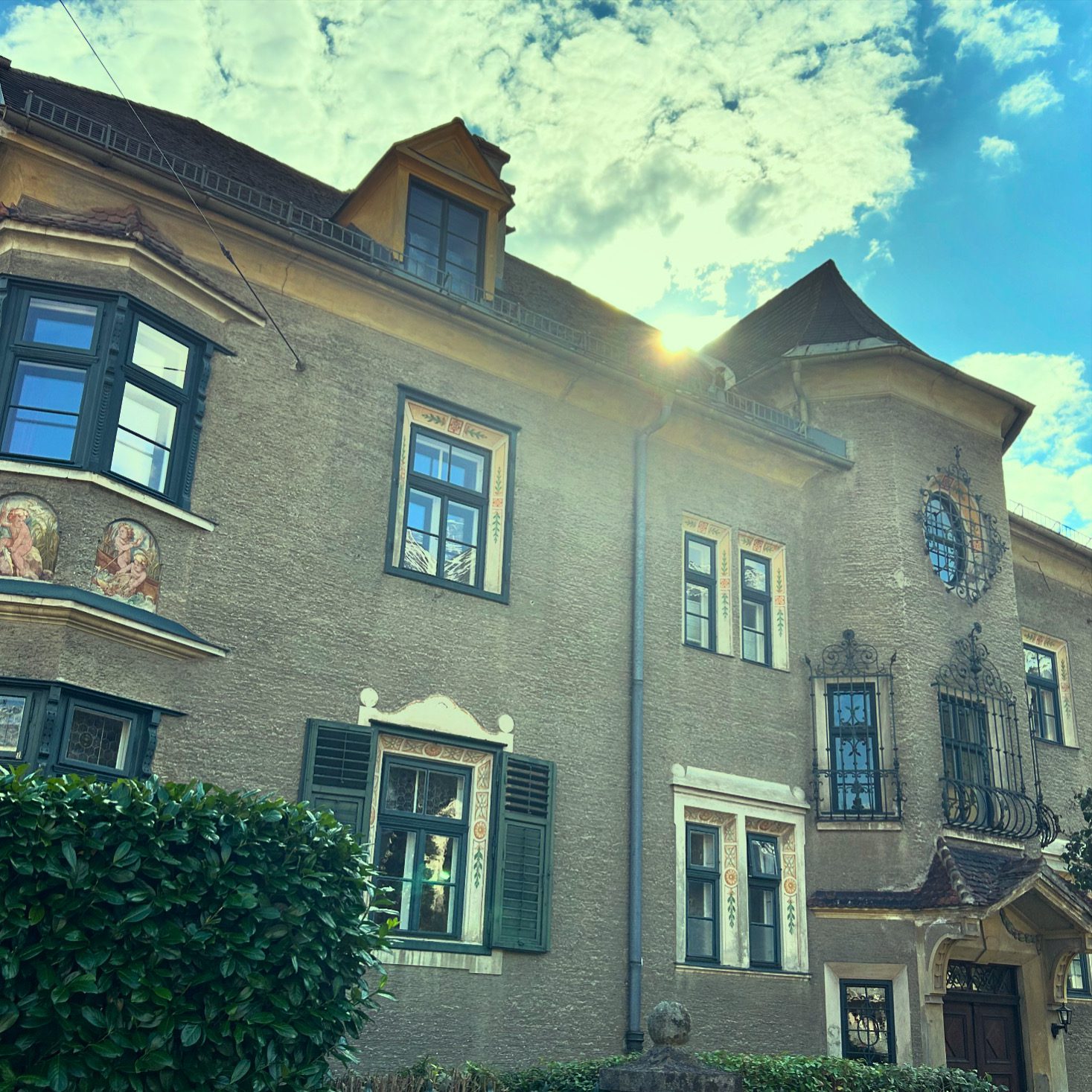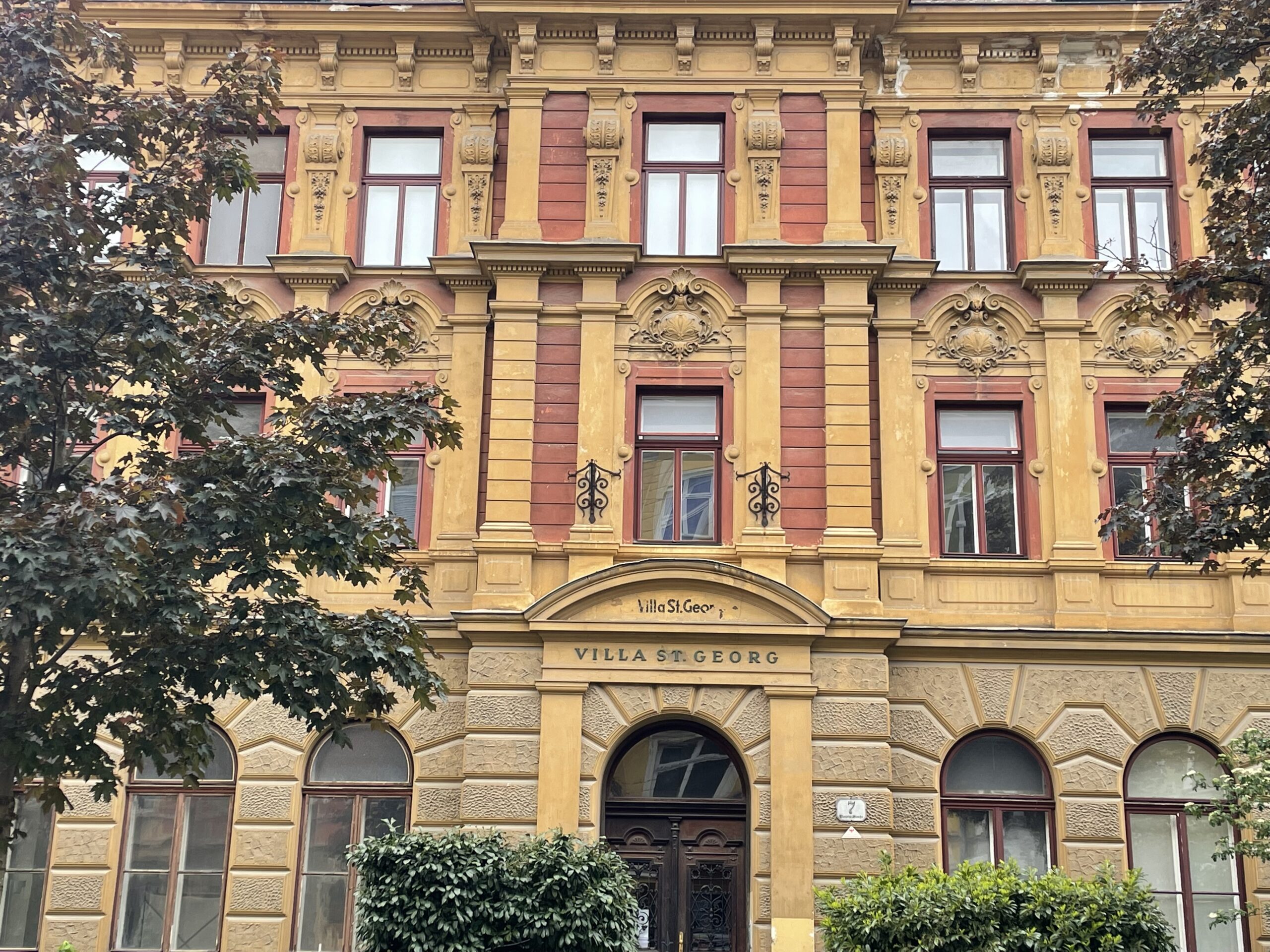Villensaggen
Kaiserjägerstraße - Falkstraße - Claudiastraße - Gänsbacherstraße - Bienerstraße
Worth knowing
Hardly anyone in Innsbruck can claim never to have dreamed of living in one of the beautiful villas in Saggen. Between Kaiserjägerstrasse, Siebererstrasse and Claudiastrasse are some of the most beautiful houses in the city. The Villensaggen with its beautiful avenues, manicured gardens and stately homes, takes strollers back to the days of the late monarchy. Innsbruck's posh neighbourhood developed towards the end of the 19th century as a kind of ghetto for the upper middle classes. If you look at a historical map from 1880, you can see that the area between the monumental Kettenbrücke bridge in the north and the monastery barracks near the Hofgarten was more or less undeveloped. The city map from 1910 already shows more or less the buildings that still exist today. Within less than thirty years, a neighbourhood had been created on a greenfield site.
The first villa was built at Bienerstraße 1 and still exudes the splendour and charm of a Victorian English-style property. Neighbouring houses gradually sprang up like mushrooms. The main axis of the new settlement was Falkstrasse. As in a Roman planned city, this avenue in the style of a Cardo Maximus was to connect the settlement from the Kettenbrücke bridge in the north to the monastery barracks near the Hofgarten. The villas were built in the style of the time by the usual suspects of the Innsbruck architecture scene. The city's master builders let off steam in the open countryside. Tyrolean Heimatstil, classicism, cottage houses and Art Nouveau are lined up in a wild mix of styles. After just over ten years of intensive construction, the area up to Claudiaplatz was developed. The neighbours were made up of Innsbruck's patrician class. With a few exceptions such as the commercial academy, which was built before 1886, the ÖBB administration building on the edge of the settlement, Johann Sieberer's orphanage, also planned before 1886, and the Evangelical Church of Christ after the turn of the century, there was hardly any infrastructure in the new neighbourhood. Wealthy tradespeople, merchants, entrepreneurs, university professors and freelancers remained undisturbed by city life in their hideaways without being disturbed by shops, factories, churchgoers or restaurants. In 1898, the municipal council under Mayor Greil put a stop to the hustle and bustle in what the press affectionately called the Stadtsaggen square, which was named Planquadrat. Only residential buildings with at least two storeys were allowed to be built to the east of Claudiastrasse. The time when villas were built in the spacious cottage style was lost in the combination of a lack of space and a growing population. Anyone who wanted to fulfil their dream of a bourgeois residence outside the hustle and bustle of the city after 1900 had to move to the new, even more exclusive neighbourhood up on Hungerburg.
One of the most striking buildings is the Villa Exl in Falkstraße 19. In 1896, the Innsbruck municipal councillor Karl Wildling had the house built as a Villa Alpenheim by the company Josef Mayr & Söhne in the Tyrolean Heimatstil at the north-eastern end of the Stadtsaggen. Mayr was responsible for several houses in this style, for example the Villa Fiegl at Elisabethstraße 3, with Our Lady of Mercy Mariahilf decorating the façade, was involved in the planning. The façade patriotically depicts St George, the patron saint of Tyrol, and St Christopher. The enterprising Wildling, who also invested diligently in property in the city centre, sold his Alpine home. After several changes of ownership, the house came into the possession of the famous Exl theatre family in 1918. With the same humility that is bestowed on pop and film stars today, they renamed their property Villa Exl and had the inscription placed under St Christoph. When the last heiress from this dynasty died in 2009, she bequeathed the villa to her foundation. As part of a refurbishment, an inconspicuous wooden building was tastefully placed next to the Tyrolean Heimatstil house.
The corner of Bienerstraße and Claudiastraße at the other end of the neighbourhood is home to two neo-Renaissance villas that are well worth seeing. The smaller building is the Fischervilla, which was built in 1896 for the Innsbruck pharmacist Carl Fischer. The orange Villa St George is located at the very edge of the Villensaggen in Claudiastrasse. Thanks to its unusual height for the Villensaggen and its massive, cubic form, it formed an almost naturally organic-looking border to the Blocksaggen like a particularly striking outpost. The three-storey residential building was commissioned by a master butcher from the master builders Gogl & Hupfauf in planning. The first owner and operator of the Restoration Claudia in the annex was the tourism expert Sebastian Kandler. He also sold the building after a short time in order to devote himself to the development of the Hungerburg. After several changes of ownership, the pub had to close its doors in 1925 due to an official refusal to grant a licence. Despite several additions, the magnificent building with its beautiful gardens still exudes the charm of the turn of the century.
The Villensaggen has survived the air raids during the Second World War in its original form, surprisingly unscathed. In aerial photographs, the area looks like a well-composed collection of small castles. Almost all of the buildings are listed and form the backdrop for wonderful walks away from the crowds of tourists.
Klingler, Huter, Retter & Co: master builders of expansion
he buildings of the late monarchy still characterise the cityscape of Innsbruck today. The last decades of the 19th century were characterised as Wilhelminian style in the history of Austria. After an economic crisis in 1873, the city began to expand in a revival. From 1880 to 1900, Innsbruck's population grew from 20,000 to 26,000. Wilten, which was incorporated in 1904, tripled in size from 4,000 to 12,000. Between 1850 and 1900, the number of buildings within the city grew from 600 to over 900, most of which were multi-storey apartment blocks, unlike the small buildings of the early modern period. The infrastructure also changed in the course of technical innovations. Gas, water and electricity became part of everyday life for more and more people. The old city hospital gave way to the new hospital. The orphanage and Sieberer's old people's asylum were built in Saggen.
The buildings constructed in the new neighbourhoods were a reflection of this new society. Entrepreneurs, freelancers, employees and workers with political voting rights developed different needs than subjects without this right. From the 1870s, a modern banking system emerged in Innsbruck. Credit institutions such as the Sparkasse, founded in 1821, or the Kreditanstalt, whose building erected in 1910 still stands like a small palace in Maria-Theresien-Straße, not only made it possible to take out loans, but also acted as builders themselves. The apartment blocks that were built also enabled non-homeowners to lead a modern life. Unlike in rural areas of Tyrol, where farming families and their farmhands and maids lived in farmhouses as part of a clan, life in the city came close to the family life we know today. The living space had to correspond to this. The lifestyle of city dwellers demanded multi-room flats and open spaces for relaxation after work. The wealthy middle classes, consisting of entrepreneurs and freelancers, had not yet overtaken the aristocracy, but they had narrowed the gap. They were the ones who not only commissioned private building projects, but also decided on public buildings through their position on the local council.
The 40 years before the First World War were a kind of gold-rush period for construction companies, craftsmen, master builders and architects. The buildings reflected the world view of their clients. Master builders combined several roles and often replaced the architect. Most clients had very clear ideas about what they wanted. They were not to be breathtaking new creations, but copies and references to existing buildings. In keeping with the spirit of the times, the Innsbruck master builders designed the buildings in the styles of historicism and classicism as well as the Tyrolean Heimatstil in accordance with the wishes of the financially strong clients. The choice of style used to build a home was often not only a visual but also an ideological statement by the client. Liberals usually favoured classicism, while conservatives were in favour of the Tyrolean Heimatstil. While the Heimatstil was neo-baroque and featured many paintings, clear forms, statues and columns were style-defining elements in the construction of new classicist buildings. The ideas that people had of classical Greece and ancient Rome were realised in a sometimes wild mix of styles. Not only railway stations and public buildings, but also large apartment blocks and entire streets, even churches and cemeteries were built in this design along the old corridors. The upper middle classes showed their penchant for antiquity with neoclassical façades. Catholic traditionalists had images of saints and depictions of Tyrol's regional history painted on the walls of their Heimatstil houses. While neoclassicism dominates in Saggen and Wilten, most of the buildings in Pradl are in the conservative Heimatstil style.
For a long time, many building experts turned up their noses at the buildings of the upstarts and nouveau riche. Heinrich Hammer wrote in his standard work "Art history of the city of Innsbruck":
"Of course, this first rapid expansion of the city took place in an era that was unfruitful in terms of architectural art, in which architecture, instead of developing an independent, contemporary style, repeated the architectural styles of the past one after the other."
The era of large villas, which imitated the aristocratic residences of days gone by with a bourgeois touch, came to an end after a few wild decades due to a lack of space. Further development of the urban area with individual houses was no longer possible, the space had become too narrow. The area of Falkstrasse / Gänsbachstrasse / Bienerstrasse is still regarded as a neighbourhood today. Villensaggenthe areas to the east as Blocksaggen. In Wilten and Pradl, this type of development did not even occur. Nevertheless, master builders sealed more and more ground in the gold rush. Albert Gruber gave a cautionary speech on this growth in 1907, in which he warned against uncontrolled growth in urban planning and land speculation.
"It is the most difficult and responsible task facing our city fathers. Up until the 1980s (note: 1880), let's say in view of our circumstances, a certain slow pace was maintained in urban expansion. Since the last 10 years, however, it can be said that cityscapes have been expanding at a tremendous pace. Old houses are being torn down and new ones erected in their place. Of course, if this demolition and construction is carried out haphazardly, without any thought, only for the benefit of the individual, then disasters, so-called architectural crimes, usually occur. In order to prevent such haphazard building, which does not benefit the general public, every city must ensure that individuals cannot do as they please: the city must set a limit to unrestricted speculation in the area of urban expansion. This includes above all land speculation."
A handful of master builders and the Innsbruck building authority accompanied this development in Innsbruck. If Wilhelm Greil is described as the mayor of the expansion, the Viennese-born Eduard Klingler (1861 - 1916) probably deserves the title of its architect. Klingler played a key role in shaping Innsbruck's cityscape in his role as a civil servant and master builder. He began working for the state of Tyrol in 1883. In 1889, he joined the municipal building department, which he headed from 1902. In Innsbruck, the commercial academy, the Leitgebule school, the Pradl cemetery, the dermatological clinic in the hospital area, the municipal kindergarten in Michael-Gaismair-Straße, the Trainkaserne (note: today a residential building), the market hall and the Tyrolean State Conservatory are all attributable to Klingler as head of the building department. The Ulrichhaus on Mount Isel, which is now home to the Alt-Kaiserjäger-Club, is a building worth seeing in the Heimatstil style based on his design.
The most important building office in Innsbruck was Johann Huter & Sons. Johann Huter took over his father's brickworks. In 1856, he acquired the first company premises, the Hutergründeon the Innrain. Three years later, the first prestigious headquarters were built in Meranerstraße. The company registration together with his sons Josef and Peter in 1860 marked the official start of the company that still exists today. Huter & Söhne like many of its competitors, saw itself as a complete service provider. The company had its own brickworks, a cement factory, a joinery and a locksmith's shop as well as a planning office and the actual construction company. In 1906/07, the Huters built their own company headquarters at Kaiser-Josef-Straße 15 in the typical style of the last pre-war years. The stately house combines the Tyrolean Heimatstil surrounded by gardens and nature with neo-Gothic and neo-Romanesque elements. Famous from Huter & Söhne buildings erected in Innsbruck include the Monastery of Perpetual Adoration, the parish church of St Nicholas, the first building of the new clinic and several buildings on Claudiaplatz. Shortly before the outbreak of the First World War, the construction company employed more than 700 people.
The second major player was Josef Retter (1872 - 1954). Born in Lower Austria with Tyrolean roots, he completed an apprenticeship as a bricklayer before joining the k.k. State Trade School in Vienna and attended the foreman's school in the building trade department. After gaining professional experience in Vienna, Croatia and Bolzano throughout the Danube Monarchy, he was able to open his own construction company in Innsbruck at the age of 29 thanks to his wife's dowry. Like Huter, his company also included a sawmill, a sand and gravel works and a workshop for stonemasonry work. In 1904, he opened his residential and office building at Schöpfstraße 23a, which is still used today as a Rescuer's house is well known. The dark, neo-Gothic building with its striking bay window with columns and a turret is adorned with a remarkable mosaic depicting an allegory of architecture. The gable relief shows the combination of art and craftsmanship, a symbol of Retter's career. His company was particularly influential in Wilten and Saggen. With the new Academic Grammar School, the castle-like school building for the Commercial Academy, the Evangelical Church of Christ in Saggen, the Zelgerhaus in Anichstraße, the Sonnenburg in Wilten and the neo-Gothic Mentlberg Castle on Sieglanger, he realised many of the most important buildings of this era in Innsbruck.
Late in life but with a similarly practice-orientated background that was typical of 19th century master builders, Anton Fritz started his construction company in 1888. He grew up remotely in Graun in the Vinschgau Valley. After working as a foreman, plasterer and bricklayer, he decided to attend the trade school in Innsbruck at the age of 36. Talent and luck brought him his breakthrough as a planner with the country-style villa at Karmelitergasse 12. In its heyday, his construction company employed 150 people. In 1912, shortly before the outbreak of the First World War and the resulting slump in the construction industry, he handed over his company to his son Adalbert. Anton Fritz's legacy includes his own home at Müllerstraße 4, the Mader house in Glasmalereistraße and houses on Claudiaplatz and Sonnenburgplatz.
With Carl Kohnle, Carl Albert, Karl Lubomirski and Simon Tommasi, Innsbruck had other master builders who immortalised themselves in the cityscape with buildings typical of the late 19th century. They all made Innsbruck's new streets shine in the prevailing architectural zeitgeist of the last 30 years of the Danube Monarchy. Residential buildings, railway stations, official buildings and churches in the vast empire between the Ukraine and Tyrol looked similar across the board. New trends such as Art Nouveau emerged only hesitantly. In Innsbruck, it was the Munich architect Josef Bachmann who set a new accent in civic design with the redesign of the façade of the Winklerhaus. Building activity came to a halt at the beginning of the First World War. After the war, the era of neoclassical historicism and Heimatstil was finally history. Times were more austere and the requirements for residential buildings had changed. More important than a representative façade and large, stately rooms became affordable living space and modern facilities with sanitary installations during the housing shortage of the sparse, young Republic of German-Austria. The more professional training of master builders and architects at the k.k. Staatsgewerbeschule also contributed to a new understanding of the building trade than the often self-taught veterans of the gold-digger era of classicism had. Walks in Saggen and parts of Wilten and Pradl still take you back to the days of the Wilhelminian style. Claudiaplatz and Sonnenburgplatz are among the most impressive examples. The construction company Huter and Sons still exists today. The company is now located in Sieglanger in Josef-Franz-Huter-Straße, named after the company founder. Although the residential building in Kaiser-Josef-Straße no longer bears the company's logo, its opulence is still a relic of the era that changed Innsbruck's appearance forever. In addition to his home in Schöpfstraße, Wilten is home to a second building belonging to the Retter family. On the Innrain opposite the university is the Villa Retter. Josef Retter's eldest daughter Maria Josefa, who herself was educated by the reform pedagogue Maria Montessori, opened the first „House of the child“ of Innsbruck. Above the entrance is a portrait of the patron Josef Retter, while the south façade is adorned with a mosaic in the typical style of the 1930s, hinting at the building's original purpose. A smiling, blonde girl embraces her mother, who is holding a book, and her father, who is carrying a hammer. The small burial chapel at the Westfriedhof cemetery, which serves as the Retters' family burial place, is also a legacy of this important family for Innsbruck that is well worth seeing.
March 1848... and what it brought
The year 1848 occupies a mythical place in European history. Although the hotspots were not to be found in secluded Tyrol, but in the major metropolises such as Paris, Vienna, Budapest, Milan and Berlin, even in the Holy Land however, the revolutionary year left its mark. In contrast to the rural surroundings, an enlightened educated middle class had developed in Innsbruck. Enlightened people no longer wanted to be subjects of a monarch or sovereign, but citizens with rights and duties towards the state. Students and freelancers demanded political participation, freedom of the press and civil rights. Workers demanded better wages and working conditions. Radical liberals and nationalists in particular even questioned the omnipotence of the church.
In March 1848, this socially and politically highly explosive mixture erupted in riots in many European cities. In Innsbruck, students and professors celebrated the newly enacted freedom of the press with a torchlight procession. On the whole, however, the revolution proceeded calmly in the leisurely Tyrol. It would be foolhardy to speak of a spontaneous outburst of emotion; the date of the procession was postponed from 20 to 21 March due to bad weather. There were hardly any anti-Habsburg riots or attacks; a stray stone thrown into a Jesuit window was one of the highlights of the Alpine version of the 1848 revolution. The students even helped the city magistrate to monitor public order in order to show their gratitude to the monarch for the newly granted freedoms and their loyalty.
The initial enthusiasm for bourgeois revolution was quickly replaced by German nationalist, patriotic fervour in Innsbruck. On 6 April 1848, the German flag was waved by the governor of Tyrol during a ceremonial procession. A German flag was also raised on the city tower. Tricolour was hoisted. While students, workers, liberal-nationalist-minded citizens, republicans, supporters of a constitutional monarchy and Catholic conservatives disagreed on social issues such as freedom of the press, they shared a dislike of the Italian independence movement that had spread from Piedmont and Milan to northern Italy. Innsbruck students and marksmen marched to Trentino with the support of the k.k. The Innsbruck students and riflemen moved into Trentino to nip the unrest and uprisings in the bud. Well-known members of this corps were Father Haspinger, who had already fought with Andreas Hofer in 1809, and Adolf Pichler. Johann Nepomuk Mahl-Schedl, wealthy owner of Büchsenhausen Castle, even equipped his own company with which he marched across the Brenner Pass to secure the border.
The city of Innsbruck, as the political and economic centre of the multinational crown land of Tyrol and home to many Italian speakers, also became the arena of this nationality conflict. Combined with copious amounts of alcohol, anti-Italian sentiment in Innsbruck posed more of a threat to public order than civil liberties. A quarrel between a German-speaking craftsman and an Italian-speaking Ladin got so heated that it almost led to a pogrom against the numerous businesses and restaurants owned by Italian-speaking Tyroleans.
The relative tranquillity of Innsbruck suited the imperial house, which was under pressure. When things did not stop boiling in Vienna even after March, Emperor Ferdinand fled to Tyrol in May. According to press reports from this time, he was received enthusiastically by the population.
"Wie heißt das Land, dem solche Ehre zu Theil wird, wer ist das Volk, das ein solches Vertrauen genießt in dieser verhängnißvollen Zeit? Stützt sich die Ruhe und Sicherheit hier bloß auf die Sage aus alter Zeit, oder liegt auch in der Gegenwart ein Grund, auf dem man bauen kann, den der Wind nicht weg bläst, und der Sturm nicht erschüttert? Dieses Alipenland heißt Tirol, gefällts dir wohl? Ja, das tirolische Volk allein bewährt in der Mitte des aufgewühlten Europa die Ehrfurcht und Treue, den Muth und die Kraft für sein angestammtes Regentenhaus, während ringsum Auflehnung, Widerspruch. Trotz und Forderung, häufig sogar Aufruhr und Umsturz toben; Tirol allein hält fest ohne Wanken an Sitte und Gehorsam, auf Religion, Wahrheit und Recht, während anderwärts die Frechheit und Lüge, der Wahnsinn und die Leidenschaften herrschen anstatt folgen wollen. Und während im großen Kaiserreiche sich die Bande überall lockern, oder gar zu lösen drohen; wo die Willkühr, von den Begierden getrieben, Gesetze umstürzt, offenen Aufruhr predigt, täglich mit neuen Forderungen losgeht; eigenmächtig ephemere- wie das Wetter wechselnde Einrichtungen schafft; während Wien, die alte sonst so friedliche Kaiserstadt, sich von der erhitzten Phantasie der Jugend lenken und gängeln läßt, und die Räthe des Reichs auf eine schmähliche Weise behandelt, nach Laune beliebig, und mit jakobinischer Anmaßung, über alle Provinzen verfügend, absetzt und anstellt, ja sogar ohne Ehrfurcht, den Kaiaer mit Sturm-Petitionen verfolgt; während jetzt von allen Seiten her Deputationen mit Ergebenheits-Addressen mit Bittgesuchen und Loyalitätsversicherungen dem Kaiser nach Innsbruck folgen, steht Tirol ganz ruhig, gleich einer stillen Insel, mitten im brausenden Meeressturme, und des kleinen Völkchens treue Brust bildet, wie seine Berge und Felsen, eine feste Mauer in Gesetz und Ordnung, für den Kaiser und das Vaterland."
In June, a young Franz Josef, not yet emperor at the time, also stayed at the Hofburg on his way back from the battlefields of northern Italy instead of travelling directly to Vienna. Innsbruck was once again the royal seat, if only for one summer. While blood was flowing in Vienna, Milan and Budapest, the imperial family enjoyed life in the Tyrolean countryside. Ferdinand, Franz Karl, his wife Sophie and Franz Josef received guests from foreign royal courts and were chauffeured in four-in-hand carriages to the region's excursion destinations such as Weiherburg Castle, Stefansbrücke Bridge, Kranebitten and high up to Heiligwasser. A little later, however, the cosy atmosphere came to an end. Under gentle pressure, Ferdinand, who was no longer considered fit for office, passed the torch of regency to Franz Josef I. In July 1848, the first parliamentary session was held in the Court Riding School in Vienna. The first constitution was enacted. However, the monarchy's desire for reform quickly waned. The new parliament was an imperial council, it could not pass any binding laws, the emperor never attended it during his lifetime and did not understand why the Danube Monarchy, as a divinely appointed monarchy, needed this council.
Nevertheless, the liberalisation that had been gently set in motion took its course in the cities. Innsbruck was given the status of a town with its own statute. Innsbruck's municipal law provided for a right of citizenship that was linked to ownership or the payment of taxes, but legally guaranteed certain rights to members of the community. Birthright citizenship could be acquired by birth, marriage or extraordinary conferment and at least gave male adults the right to vote at municipal level. If you got into financial difficulties, you had the right to basic support from the town.
Thanks to the census-based majority voting system, the Greater German liberal faction prevailed within the city government, in which merchants, tradesmen, industrialists and innkeepers set the tone. On 2 June 1848, the first edition of the liberal and Greater German-minded Innsbrucker Zeitungfrom which the above article on the emperor's arrival in Innsbruck is taken. Conservatives, on the other hand, read the Volksblatt for Tyrol and Vorarlberg. Moderate readers who favoured a constitutional monarchy preferred to consume the Bothen for Tyrol and Vorarlberg. However, the freedom of the press soon came to an end. The previously abolished censorship was reintroduced in parts. Newspaper publishers had to undergo some harassment by the authorities. Newspapers were not allowed to write against the state government, monarchy or church.
"Anyone who, by means of printed matter, incites, instigates or attempts to incite others to take action which would bring about the violent separation of a part from the unified state... of the Austrian Empire... or the general Austrian Imperial Diet or the provincial assemblies of the individual crown lands.... Imperial Diet or the Diet of the individual Crown Lands... violently disrupts... shall be punished with severe imprisonment of two to ten years."
After Innsbruck officially replaced Meran as the provincial capital in 1849 and thus finally became the political centre of Tyrol, political parties were formed. From 1868, the liberal and Greater German orientated party provided the mayor of the city of Innsbruck. The influence of the church declined in Innsbruck in contrast to the surrounding communities. Individualism, capitalism, nationalism and consumerism stepped into the breach. New worlds of work, department stores, theatres, cafés and dance halls did not supplant religion in the city either, but the emphasis changed as a result of the civil liberties won in 1848.
Perhaps the most important change to the law was the Basic relief patent. In Innsbruck, the clergy, above all Wilten Abbey, held a large proportion of the peasant land. The church and nobility were not subject to taxation. In 1848/49, manorial rule and servitude were abolished in Austria. Land rents, tithes and roboters were thus abolished. The landlords received one third of the value of their land from the state as part of the land relief, one third was regarded as tax relief and the farmers had to pay one third of the relief themselves. They could pay off this amount in instalments over a period of twenty years.
The after-effects can still be felt today. The descendants of the then successful farmers enjoy the fruits of prosperity through inherited land ownership, which can be traced back to the land relief of 1848, as well as political influence through land sales for housing construction, leases and public sector redemptions for infrastructure projects. The land-owning nobles of the past had to resign themselves to the ignominy of pursuing middle-class labour. The transition from birthright to privileged status within society was often successful thanks to financial means, networks and education. Many of Innsbruck's academic dynasties began in the decades after 1848.
Das bis dato unbekannte Phänomen der Freizeit kam, wenn auch für den größten Teil nur spärlich, auf und begünstigte gemeinsam mit frei verfügbarem Einkommen einer größeren Anzahl an Menschen Hobbies. Zivile Organisationen und Vereine, vom Lesezirkel über Sängerbünde, Feuerwehren und Sportvereine, gründeten sich. Auch im Stadtbild manifestierte sich das Revolutionsjahr. Parks wie der Englische Garten beim Schloss Ambras oder der Hofgarten waren nicht mehr exklusiv der Aristokratie vorbehalten, sondern dienten den Bürgern als Naherholungsgebiete vom beengten Dasein. In St. Nikolaus entstand der Waltherpark als kleine Ruheoase. Einen Stock höher eröffnete im Schloss Büchsenhausen Tirols erste Schwimm- und Badeanstalt, wenig später folgte ein weiteres Bad in Dreiheiligen. Ausflugsgasthöfe rund um Innsbruck florierten. Neben den gehobenen Restaurants und Hotels entstand eine Szene aus Gastwirtschaften, in denen sich auch Arbeiter und Angestellte gemütliche Abende bei Theater, Musik und Tanz leisten konnten.
Wilhelm Greil: DER Bürgermeister Innsbrucks
One of the most important figures in the town's history was Wilhelm Greil (1850 - 1923). From 1896 to 1923, the entrepreneur held the office of mayor, having previously helped to shape the city's fortunes as deputy mayor. It was a time of growth, the incorporation of entire neighbourhoods, technical innovations and new media. The four decades between the economic crisis of 1873 and the First World War were characterised by unprecedented economic growth and rapid modernisation. Private investment in infrastructure such as railways, energy and electricity was desired by the state and favoured by tax breaks in order to lead the countries and cities of the ailing Danube monarchy into the modern age. The city's economy boomed. Businesses sprang up in the new districts of Pradl and Wilten, attracting workers. Tourism also brought fresh capital into the city. At the same time, however, the concentration of people in a confined space under sometimes precarious hygiene conditions also brought problems. The outskirts of the city and the neighbouring villages in particular were regularly plagued by typhus.
Innsbruck city politics, in which Greil was active, was characterised by the struggle between liberal and conservative forces. Greil belonged to the "Deutschen Volkspartei", a liberal and national-Great German party. What appears to be a contradiction today, liberal and national, was a politically common and well-functioning pair of ideas in the 19th century. The Pan-Germanism was not a political peculiarity of a radical right-wing minority, but rather a centrist trend, particularly in German-speaking cities in the Reich, which was significant in various forms across almost all parties until after the Second World War. Innsbruckers who were self-respecting did not describe themselves as Austrians, but as Germans. Those who were members of the liberal Innsbrucker Nachrichten of the period around the turn of the century, you will find countless articles in which the common ground between the German Empire and the German-speaking countries was made the topic of the day, while distancing themselves from other ethnic groups within the multinational Habsburg Empire. Greil was a skilful politician who operated within the predetermined power structures of his time. He knew how to skilfully manoeuvre around the traditional powers, the monarchy and the clergy and to come to terms with them.
Taxes, social policy, education, housing and the design of public spaces were discussed with passion and fervour. Due to an electoral system based on voting rights via property classes, only around 10% of the entire population of Innsbruck were able to go to the ballot box. Women were excluded as a matter of principle. Relative suffrage applied within the three electoral bodies, which meant as much as: The winner takes it all. Greil wohne passenderweise ähnlich wie ein Renaissancefürst. Er entstammte der großbürgerlichen Upper Class. Sein Vater konnte es sich leisten, im Palais Lodron in der Maria-Theresienstraße die Homebase der Familie zu gründen. Massenparteien wie die Sozialdemokratie konnten sich bis zur Wahlrechtsreform der Ersten Republik nicht durchsetzen. Konservative hatten es in Innsbruck auf Grund der Bevölkerungszusammensetzung, besonders bis zur Eingemeindung von Wilten und Pradl, ebenfalls schwer. Bürgermeister Greil konnte auf 100% Rückhalt im Gemeinderat bauen, was die Entscheidungsfindung und Lenkung natürlich erheblich vereinfachte. Bei aller Effizienz, die Innsbrucker Bürgermeister bei oberflächlicher Betrachtung an den Tag legten, sollte man nicht vergessen, dass das nur möglich war, weil sie als Teil einer Elite aus Unternehmern, Handelstreibenden und Freiberuflern ohne nennenswerte Opposition und Rücksichtnahme auf andere Bevölkerungsgruppen wie Arbeitern, Handwerkern und Angestellten in einer Art gewählten Diktatur durchregierten. Das Reichsgemeindegesetz von 1862 verlieh Städten wie Innsbruck und damit den Bürgermeistern größere Befugnisse. Es verwundert kaum, dass die Amtskette, die Greil zu seinem 60. Geburtstag von seinen Kollegen im Gemeinderat verliehen bekam, den Ordensketten des alten Adels erstaunlich ähnelte.
Under Greil's aegis and the general economic upturn, fuelled by private investment, Innsbruck expanded at a rapid pace. In true merchant style, the municipal council purchased land with foresight in order to enable the city to innovate. The politician Greil was able to rely on the civil servants and town planners Eduard Klingler, Jakob Albert and Theodor Prachensky for the major building projects of the time. Infrastructure projects such as the new town hall in Maria-Theresienstraße in 1897, the opening of the Mittelgebirgsbahn railway, the Hungerburgbahn and the Karwendelbahn wurden während seiner Regierungszeit umgesetzt. Weitere gut sichtbare Meilensteine waren die Erneuerung des Marktplatzes und der Bau der Markthalle. Neben den prestigeträchtigen Großprojekten entstanden in den letzten Jahrzehnten des 19. Jahrhunderts aber viele unauffällige Revolutionen. Vieles, was in der zweiten Hälfte des 19. Jahrhunderts vorangetrieben wurde, gehört heute zum Alltag. Für die Menschen dieser Zeit waren diese Dinge aber eine echte Sensation und lebensverändernd. Bereits Greils Vorgänger Bürgermeister Heinrich Falk (1840 – 1917) hatte erheblich zur Modernisierung der Stadt und zur Besiedelung des Saggen beigetragen. Seit 1859 war die Beleuchtung der Stadt mit Gasrohrleitungen stetig vorangeschritten. Mit dem Wachstum der Stadt und der Modernisierung wurden die Senkgruben, die in Hinterhöfen der Häuser als Abort dienten und nach Entleerung an umliegende Landwirte als Dünger verkauft wurden, zu einer Unzumutbarkeit für immer mehr Menschen. 1880 wurde das RaggingThe city was responsible for the emptying of the lavatories. Two pneumatic machines were to make the process at least a little more hygienic. Between 1887 and 1891, Innsbruck was equipped with a modern high-pressure water pipeline, which could also be used to supply fresh water to flats on higher floors. For those who could afford it, this was the first opportunity to install a flush toilet in their own home.
Greil continued this campaign of modernisation. After decades of discussions, the construction of a modern alluvial sewerage system began in 1903. Starting in the city centre, more and more districts were connected to this now commonplace luxury. By 1908, only the Koatlackler Mariahilf und St. Nikolaus nicht an das Kanalsystem angeschlossen. Auch der neue Schlachthof im Saggen erhöhte Hygiene und Sauberkeit in der Stadt. Schlecht kontrollierte Hofschlachtungen gehörten mit wenigen Ausnahmen der Vergangenheit an. Das Vieh kam im Zug am Sillspitz an und wurde in der modernen Anlage fachgerecht geschlachtet. Greil überführte auch das Gaswerk in Pradl und das Elektrizitätswerk in Mühlau in städtischen Besitz. Die Straßenbeleuchtung wurde im 20. Jahrhundert von den Gaslaternen auf elektrisches Licht umgestellt. 1888 übersiedelte das Krankenhaus von der Maria-Theresienstraße an seinen heutigen Standort. Bürgermeister und Gemeinderat konnten sich bei dieser Innsbrucker Renaissance neben der wachsenden Wirtschaftskraft in der Vorkriegszeit auch auf Mäzen aus dem Bürgertum stützen. Waren technische Neuerungen und Infrastruktur Sache der Liberalen, verblieb die Fürsorge der Ärmsten weiterhin bei klerikal gesinnten Kräften, wenn auch nicht mehr bei der Kirche selbst. Freiherr Johann von Sieberer stiftete das Greisenasyl und das Waisenhaus im Saggen. Leonhard Lang stiftete das Gebäude in der Maria-Theresienstraße, in der sich bis heute das Rathaus befindet gegen das Versprechen der Stadt ein Lehrlingsheim zu bauen.
Im Gegensatz zur boomenden Vorkriegsära war die Zeit nach 1914 vom Krisenmanagement geprägt. In seinen letzten Amtsjahren begleitete Greil Innsbruck am Übergang von der Habsburgermonarchie zur Republik durch Jahre, die vor allem durch Hunger, Elend, Mittelknappheit und Unsicherheit geprägt waren. Er war 68 Jahre alt, als italienische Truppen nach dem Ersten Weltkrieg die Stadt besetzten und Tirol am Brenner geteilt wurde. Das Ende der Monarchie und des Zensuswahlrechts bedeuteten auch den Niedergang der Liberalen in Innsbruck, auch wenn Greil das in seiner aktiven Karriere nur teilweise miterlebte. 1919 konnten die Sozialdemokraten in Innsbruck zwar zum ersten Mal den Wahlsieg davontragen, dank der Mehrheiten im Gemeinderat blieb Greil aber Bürgermeister. 1928 verstarb er als Ehrenbürger der Stadt Innsbruck im Alter von 78 Jahren. Die Wilhelm-Greil-Straße war noch zu seinen Lebzeiten nach ihm benannt worden.
Theatres, country stages, cinemas & Kuno
The Tyrolean State Theatre opposite the Hofburg with its neoclassical façade is still the city's most striking monument to bourgeois, urban evening entertainment. Since its inception, however, this theatre of high culture has largely eked out a dreary existence in terms of audience numbers. From baroque plays about the Passion of Christ in the 16th century to daring productions that were often met with little applause from the audience almost 500 years later, the goings-on at the Landestheater were always the hobbyhorse of a small elite. The majority of Innsbruck's inhabitants passed the time with profane amusements.
Showmen and travelling folk have always been welcome guests in cities. Just like today, there was strict censorship of public performances in the past. What today are age restrictions on cinema films, in the past were restrictions on performances that were not pleasing to God and even complete bans on theatre and drama under particularly pious sovereigns. However, with increasing bourgeoisie and more enlightened moral concepts, the rules gradually became more relaxed.
The Pradler BauerntheaterThe first venue was an open-air stage in the Höttinger Au and, in addition to farmers, craftsmen and students were also part of the ensemble, but this should not detract from the honour of its name and origins. While the state theatre often played to half-empty seats, the amateur actors enjoyed great popularity with their comedies. Employees and labourers made the pilgrimage from the city to the venues in the surrounding villages at the weekend or enjoyed the evening entertainment in pubs. The so-called knight plays with kidnapped princesses, heroic saviours and clumsy villains were particularly popular. Unlike the serious plays in bourgeois theatres, the actors in the peasant theatres interacted with the audience. Interjections from the audience were not stopped, but spontaneously incorporated into the play. It could even happen that the audience, who were not always sober, intervened in the action with their hands.
With increasing success, the company gradually began to professionalise. In 1870, the Pradler Bauerntheater in a hay barn converted into a stage at the Lodronischen Hof in the Egerdachstraße. In the time before the triumph of television, Innsbruck had a whole series of theatres and pubs that entertained their audiences with plays and music. In 1892, the Löwenhaus theatre opened on Rennweg, where the Tyrolean regional studio of the ORF is located today. The wooden building burnt down in the late 1950s, just in time for the rise of state broadcasting. In 1898, the Pradler were guest performers at the Ronacher in Vienna. A few years later, the young and ambitious Ferdinand Exl (1875 - 1942) broke new ground with part of the troupe. For a long time, the saying went: „If you want to go to a farmer's theatre, you won't get your money's worth in the theatre, and if you're not just looking for entertainment in the theatre, but literary stimulation, you won't go to a farmer's theatre." Exl recognised the trend of the time. Employees and workers could not afford the horrendous ticket prices of the state theatre and did not want to see Wagner operas or plays like The Sorrows of Young Werther However, a certain quality of content and presentation was expected. With the so-called literary folk plays by renowned local authors such as Ludwig Anzengruber, Franz Kranewitter and Karl Schönherr, Exl combined entertainment and quality. Anzengruber summarised the development:
„Anzengruber's Tyroleans not only sing Schnaderhüpfel, platteln d'Schuh, swear like Croats and scuffle, but they are also people with a subtle psyche who have their own thoughts about various problems and develop their own philosophy.“
The first play staged by Exl The priest of Kirchfeld from the pen of Anzengruber was published in 1902 in the Österreichischen Hof on the stage in Wilten. The troupe consisted mainly of members of the Exl and Auer families. In 1903, the company known as Exl stage well-known theatre company Adambräu in Adamgasse, from 1904 to 1915 played popular hits such as Kranewitter's pieces Michael Gaismair und Andre Hofer im Lion house at the Hofgarten. In addition to the plays, tourists were also treated to typical local entertainment such as zither recitals and "genuine, smart Tyrolean Schuhplattler dance" was offered. The first international tour to Switzerland and Germany began in 1904. The press and audiences were enthusiastic about the German-national flavoured pieces performed by pithy Tyrolean lads and pretty girls. In 1910, Exl bid farewell to its existence as an amateur troupe and, in addition to a few veterans, mainly hired "Townspeople" and professional actors.
However, the First World War and the associated travel restrictions put the brakes on further tours. The troupe became part of the Innsbruck City Theatrewhose audience was also receptive to lighter fare during the hard times. Ernst Nepo, an artist who was characterised by his Germanism and early membership of the NSDAP, was responsible for the stage sets.
After the toughest post-war years, things started to look up again. From 1924, the Exl stage In addition to the Stadttheater, Exl also regularly performed at the Raimundtheater and the Wiener Komödienhaus in winter. The political developments of the 1930s greatly favoured the German folk spirit that was inherent in many of the plays that Exl brought to the stage. Like Nepo, he also joined the NSDAP, which was banned in Austria, in 1933. A year later, he planned his first tour of the German Reich. The Austrian government, led by Dollfuß, banned the performances in a last stand against the National Socialists. It was not until 1935 that the Exl Bühne in Berlin was able to stage Karl Schönherr's play Faith and home perform. The Berliner Morgenpost of 4 April 1935 described the piece as "...Art that flows from the depths of the German nation and flows back into the hearts of moved and grateful listeners". After 1938, Exl also received media support in Vienna and became known as "...the antithesis of the completely Judaised, artistically Bolshevised... theatre business" was celebrated. The founder of Exl Bühne died in 1942. His wife and son took over the business and became part of the Tyrolean State Theatre after the war. In the 1950s, the theatre group once again toured successfully in West and East Germany before disbanding in 1956.
Times had changed, Cinema killed the Theatre Star. Moving pictures in cinemas were competing with the stage. The enterprising Ferdinand Exl had also foreseen this development early on. In 1912, his ensemble appeared in the French film Speckbacher which heroically portrayed the Tyrolean uprising. The first cinema film flickered across the screen in the Stadtsaal in Innsbruck in 1896, just one year after the world's first ever cinema, in front of a fascinated audience. The cinema quickly became part of everyday life for many people. In addition to silent films, audiences were shown propaganda messages, especially during the war. Cinemas sprang up like mushrooms in the following decades. In 1909, a cinema opened at Maria-Theresien-Straße 10, which was later known as the Central moved to Maria-Theresien-Straße 37. After the war, it became the Nonstop cinemawhere you paid your ticket for a run of news, cartoons, adverts and feature films that was constantly repeated. In 1928, the Red Cross opened the Kammer Lichtspiele in Wilhelm-Greilstraße to finance the new clubhouse. The Triumph was located at Maria-Theresien-Straße 17 and remained a central cinema until the 1990s. Dreiheiligen was home to the Forum cinema, which is now the Z6 youth centre. In 1933, the Höttinger Gasse opened the Lion cinemawhich was built in 1959 as the Metropol in the listed Malfatti house opposite the Inn bridge, where it still exists today. In the final phase of the Second World War, the Laurin light shows Innsbruck's largest cinema in the middle of the South Tyrolean settlement in Gumppstraße opened its doors. Robert and Walter Kinigadner, two South Tyrolean optants who had already gained experience in the cinema industry in Brixen, took over the running of the 800-seat cinema. Harmless local films alternated with Nazi propaganda. The Exl stage used the Laurin, which functioned as a cinema until the 1970s, for theatre performances. Today, a supermarket is located behind the pillars at the formerly grand entrance. On the wall above the cash desk area, you can still see the murals depicting the legend of the legendary dwarf king Laurin and the German hero Dietrich von Bern in the typical look of National Socialist art. In 1958, on the premises of the former Innsbruck Catholic Workers' Association, the Leocinemawhich is still in operation today and is an integral part of the Innsbruck film scene.
For a short time, cinema and theatre coexisted before cinema took the upper hand. At its peak in 1958, Innsbruck's cinemas sold an incredible 3.5 million tickets. Then the television in the living room gradually took over information and evening entertainment. In addition to entertainment, the cinema also took on a role in sexual education. In the 1970s, naked breasts flickered across the screens for the first time. Films such as Schulmädchenreport and Josefine Mutzenbacher also brought the sexual revolution a little closer to the Tyroleans.
When the Austrian Broadcasting When the new radio went on air in 1955, hardly anyone had a terminal to receive the meagre programme. That was soon to change. In Innsbruck, the Metropol at the Inn bridge and the new bridge built at the turn of the millennium Cineplexx There are still two big players in Wilten. Cinematograph und Leocinema are aimed at an alternative audience away from the blockbusters. The open-air cinema takes place in the Zeughaus in August. The Pradl theatre troupe has survived to this day, albeit under a new name. In 1958, they found a new home in the Bierstindl cultural pub. The amateur theatre troupe Innsbruck Knights' Games enjoys great popularity and full ranks to this day. The play The rogue Kuno von Drachenfels revives the tradition of past centuries every year, including a repeat of the beheading scene and humorous interaction with the audience. A street in the Höttinger Au neighbourhood commemorates Ferdinand Exl. The Alpenheim country house in Saggen, better known today as Villa Exl, where the family lived, is a Tyrolean Heimatstil building with paintings by Raphael Thaler that is well worth seeing.
